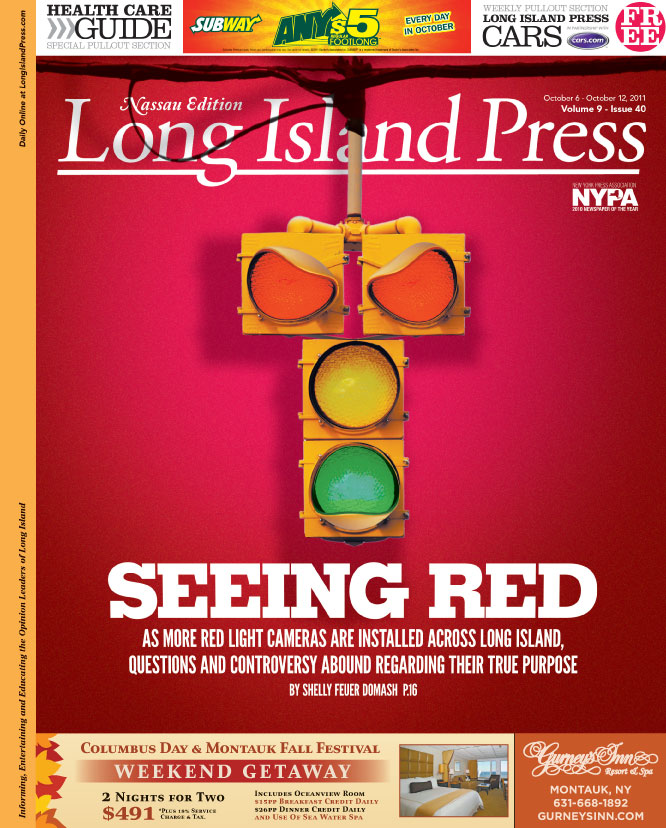
SHOW US THE MONEY
With millions of dollars at stake for the industry, spending money on politicians, lobbying and lawsuits have become a routine part of doing business, especially for ATS.
When asked by the Press how much they actually spent on influencing politicians and hiring lobbyists, Territo replies, “I have no idea.” He adds, “We would spend less on lobbyists if there weren’t legislators looking to outlaw the use of cameras; and as far as political contributions, we support candidates who support what we do and recognize the benefits of red light safety cameras.”
ATS has vowed to continue challenging all public initiatives and to persist in their fight to increase the number of cameras. Published reports reveal that ATS spent as much as $1.5 million lobbying public officials and contributing to political campaigns in Florida alone. Here in New York, between May 2005 and June 2011, the company spent more than $372,000 on lobbying fees. The company also donated $8,250 to candidates within the Empire State.
Yet party politics are playing out on a more local level. The first 50 red light locations were considered part of a pilot project. Nassau and Suffolk counties have now requested an additional 50 cameras for each county. The state senate approved them, but it has been held up in the Assembly.
Assem. Charles Lavine (D-Glen Cove) says he is not happy with the way Nassau has been handling the program, stressing that the county was supposed to submit annual reports.
“When we won the ability to have the program, it was based on a contingency, and the contingency was that the legislature wanted to make sure that the cameras were being employed fairly and effectively, and because it is a five-year experimental program, as of close of business in Albany this year, they had only submitted one report, while the program been in existence for two years at that point,” he tells the Press. “I am not sufficiently interested in continuing the program on a permanent basis unless and until Nassau County satisfies the requirement that they submit those several annual reports.”
Mistron, Nassau’s Traffic Safety Board head, acknowledges that Nassau has not submitted any reports to the state legislature yet, but insists that the first one is due out soon.
Deputy Assembly Speaker Earlene Hooper (D-Hempstead) tells the Press she introduced new legislation that would ensure 25 percent of the proceeds from the cameras would go into “a locked box” that would be utilized solely for the purpose of youth programs, especially in the 18th Assembly district.
Hooper says that so far, she has no way to determine that Nassau’s red-light revenues are being used for safety initiatives. She wants a 60/40 cut from any such monies, with the 60 percent going to her district.
“I don’t know if the 50 are operating now. We don’t know where,” she says, referring to the original 50 corners. “We want accountability. A review will indicate where the summonses are being issued, and where the money, revenues are being put into.”
She said she has seen no reports, either, and adds that her district could not afford cameras that weren’t there for safety.
“This could lead to a person getting ticketed for the first time and fined over a period of time, and that can lead to the suspension of their driver’s license,” she laments. “They might not be able to pay $65. There is no way to determine if these cameras are going to be put in Hempstead or Garden City, Muttontown or Freeport, Kings Point or Roosevelt.”
Some on the other side of the aisle are equally frustrated.
“The Senate has passed the measure, the Assembly hasn’t, and now in August, when the legislative session has expired, they come up with arguments that they never raised during the legislative session?” blasts state Sen. Charles Fuschillo (R-Merrick).
Suffolk, according to Peterson, is also preparing its first annual report.
Lavine says he supports the cameras, but “these things ought to be implemented to save lives, reduce property damage and reduce medical injuries by placing [them] at most dangerous intersections. If however, they are not being placed at the most dangerous intersections, but are rather being placed at the busiest intersection, in order to be revenue producers, then they are nothing more than a tax. And if the county executive wants to engage in additional taxation, they ought to do that on their own without the help of the state legislature. That is one of the reasons why we want to see their reports.”
With the intervention of politics and money, the future of red light cameras on Long Island is temporarily in limbo. In the meantime, they hang above our intersections like Big Brother, watching the drivers of Nassau and Suffolk counties.




